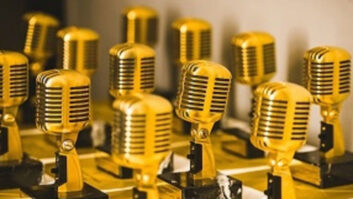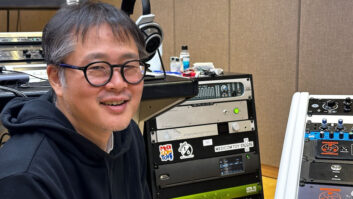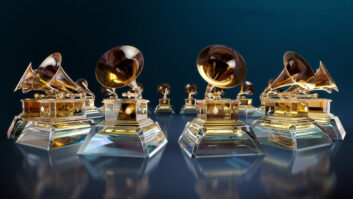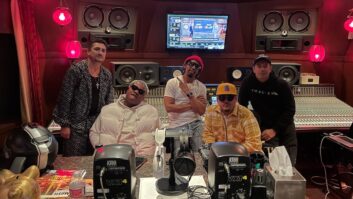
In the May issue of Mix — our annual theme issue, which focused on “Getting Noticed, Getting Heard, Getting Paid” — we explored the ways that new music business models have pushed producers to expand their services, particularly their involvement in artist development. We continually explore the changing role of the producer in these pages — sometimes from the business side, but more often from a creative perspective. The producer’s job — part bandmember, part therapist, part cheerleader, part musical mentor — constantly evolves along with the project at hand, and the business in general. Books could be written on the role of the producer — and they have been.
Mix‘s former Nashville editor, Rick Clark, is currently working on a book that delves into production techniques (Mixing, Recording, and Producing Techniques of the Pros: Insights on Recording Audio for Music, Video, Film, and Games, published by Thomson). Featured are conversational contributions from engineers, mixers and equipment developers, as well as top producers, covering topics ranging from technology to temperament. Here, with thanks to Clark, is what some of the producers have to say about their work and the state of the recording industry.
JOE BOYD
Though American born-and-raised, producer Joe Boyd made his mark in England beginning in the mid-’60s, and now has credits spanning more than four decades and scores of artists, including Fairport Convention, Nick Drake, R.E.M., Kate Bush, Pink Floyd and the Flaming Lips.
Live Band and a Live Room
Everyone talks about how much the recording process has altered in the past 30 years. And it’s true that digital recording has changed the game tremendously. But for me, the essentials remain the same: getting as much of a live feel as possible while maintaining a high-quality sound that permits achieving a mix of the highest quality. That means getting as much of the track recorded live, as well as using rooms that are live, have character and reward an approach that takes risks by forgoing isolation in most cases.
It is important that musicians have a sense of occasion and danger in recording. Putting down tracks or vocals with endless opportunities to correct and perfect accomplishes the opposite of what I look for in a recording. When there is one track left on a 16-track machine for vocals, for example, the singer and the producer have to choose after each take whether to go for another or erase the last pass. This puts everyone on edge and forces great performances out of singers.
People sometimes comment on the depth and warmth of the recordings I made with [producer/engineer] John Wood at Sound Techniques [London] in the 1960s. Recording in modern, small, dead rooms cannot accomplish this. To me, many if not most modern recordings sound shiny and two-dimensional.
You could say that 2-track recording is the purest form of record making. Four-track, 8-track, et cetera, through the present limitless expanse of possibilities on Pro Tools have all been steps backward in terms of making recordings that will endure the test of time.
NICK LAUNAY

Versatile producer/engineer/mixer Nick Launay’s credits include the Yeah Yeah Yeahs, Silverchair, Nick Cave & The Bad Seeds, The Posies, David Byrne (with and without Talking Heads), Midnight Oil and INXS.
Analog and Digital
I think analog still sounds better than digital for many reasons, but a lot of it has to do with how you line the tape machine up and what tape machine you use. It’s not just about renting any old Studer and throwing black-and-brown tape on it. It really depends on what tape you use and what level you record the different instruments at. I do, however, think that with digital we can be way more creative, allowing us to manipulate sound in wild ways. So for me, it’s a combination of both that makes for the best-sounding and most imaginative recordings.
Nowadays, you’ll find a lot of really good young engineers who know their Pro Tools and are killer with their plug-ins, but just have no idea about tape because they’ve simply never used it before. When using analog for the first time, the most common mistake is to record hi-hats, bass drum and snare really loud on tape. You can wind guitars and bass on really loud and it sounds great, but anything percussive that’s got high transients, you’ve got to leave a lot of headroom. Using analog tape is a whole art in itself.
If today’s dwindling budgets allow me to record as I prefer, I’ll go all the way analog for the basic backing track. I’ll record the band backing tracks all at once with the band playing together, in the same room, looking at each other, sometimes without headphones. I do whatever it takes to get the most energetic or moody performance. Then I will edit the 2-inch old school-style with sticky tape. I’ll often do lots of edits on the 2-inch. We might do 10 takes of a song and then decide that take 8 is the one, but the middle section was better from take 2. So I’ll go back to take 2 and edit that section into take 8 and so on.
I’ve done up to 30 analog edits in one song. When the arrangement on 2-inch is the way I want it, I’ll stripe it with code, sync it up and bounce it to Pro Tools with the idea that we’ll do all our overdubs on Pro Tools. So now we’ve got lots of extra tracks to do vocals and overdubs and go crazy with plug-ins if we want. Then at the end of the day, when it comes time to mix, I’ll sync the Pro Tools back up with the original 2-inch so that the basic backing track is analog and the rest is digital.
Analog absolutely sounds better than digital, but digital allows us musical types to get what we imagine in our heads to come out of the speakers quicker.

TONY SHEPPERD
Engineer/producer Tony Shepperd has worked with an array of popular artists, including Madonna, Kenny Loggins, Diana Ross, Lionel Ritchie, Whitney Houston and even a Cheetah Girls remix.
The Art and the Deal
I’m sure there will always be major labels around trying to push 16-year-old artists. What’s a 16-year-old going to sing about? The whole industry is going this way, and I think now you have this backlash where people are saying, “I’m going to come up with my own thing.” They create a record for $30k, and they’re touring the hell out of them.
The real [deal] out there is the indie side — the indie rock bands. They need to rob Peter or pay Paul to make this record, but it’s a great record. And that’s the kind of stuff that people want to hear. And it may only sell 10,000 copies, but those are 10,000 hardcore fans. You have major-label artists who’ve sunk one-and-a-half million dollars into a record and sold 5,000 copies.
I think there is still art that is growing out of this crap. Something is dying, but something is being born and it’s music once again. It needed to happen and get to the point where the money chasers who only wanted the money for a quick buck making records for 15-year-olds are finally either getting out of the business or realizing there’s no money in it. So go! Now, let’s get back to making some real music. I was talking to Kenny [Loggins] about this around last January. Ten years ago, 95 percent of my clients were major-label, and now 95 percent are indie. It could be an indie client like Kenny, who used to be a major-label client. Now I have indie artists who say, “I have $10k and a bunch of friends who want to make a record.” I say, “Yes, sure, we can do it!”
You can make great records that fit the artist. I produce all the time with artists one on one. You get together with the guys and figure out what’s best for them. I’m the kind of guy who will shepherd the project and put this thing together and help, but this is your album. You’ve got to let me know when this is going too far, and you know your audience and what they’re wanting to buy.
KEN COOMER

Former member of Uncle Tupelo and Wilco, drummer/producer Ken Coomer has recorded with Steve Earle, Jars of Clay and Billy Bragg. His recent production credits include Will Hoge and the Latin Grammy-nominated debut album by Mexican artist Chetes.
The Group Is Key
James Brown said it best: “You are only as good as your drummer.” Great drummers make great listeners. The drummer has to listen to the bass player, to the guitarist, the singer and everyone else in the band. The drummer is usually positioned behind the rest of the band, which puts him or her in the position of being the backbone, the driver of the band; less in a “look at me” position and more in a “listen and keep it together” position.
I am a drummer and a producer. As a drummer early on, I was a purist about my sound. If anyone had the “novel” idea of taping up the drum kit to get that “fat sound” from the ’70s or pulling the front head off the bass drum or building a “tunnel” in front of the bass drum, I had no interest in changing my sound. I was more interested in serving myself before the song, and when I look back I realize how selfish that was. I know now, as a producer, it is all about the song.
There is a famous story around [Nashville] about legend Johnny Cash. Johnny was recording at one of the famous studios here in town when a musician on the session told a fellow musician that Johnny was playing so quietly that he couldn’t hear him. Quickly the other musicians turned to this individual and told him that if he couldn’t hear Johnny, then he was playing too loud. There were no headphones used on this session. Every one of these players had to listen to Johnny and to each other. They didn’t have the eight to 16 and beyond cue mixes. Here in Nashville, we call it the “more me” box. With everyone quick to turn up themselves in the cans, we miss the objectivity that is the magic of listening.
My favorite example of the art of listening is illustrated within the walls of Motown Studios in Detroit. There are some tape machines and vintage gear still there. The amps and drums are set up as well, but the part of the tour that really knocked me out was the floor. What really threw me for a loop about this section of the floor was how worn it was in just one spot. I was curious, and then it hit me: These world-class musicians stood in the same exact spot for years plugged into one amp. When is the last time you saw more than one guitarist playing out of the same amplifier? If you go back and listen to those classic recordings, you can hear that none of those musicians ever stepped on the other player’s part. They listened to each other, not just themselves.
Listening is more than just using your ears, too. When I am working with an artist and we are trying to get the take, there will inevitably be what we call the “thinking take.” The “thinking take” may be executed with the precision of a firing squad and played to perfection, but there is nothing in my opinion that falls flat faster than the “thinking take.” Give me blemishes and squeaks, tempos speeding up and more. If it has soul and passion, it will speak to the listener. If it is precise and staid, it will be invisible to the listener. Whenever I am working with a band full of varying personalities, I like to hear the idea of the quiet guy who really does not have a lot of suggestions. I’m almost always glad I did. I ask bands to plug something into an amp that they think would never in a million years sound good. We all have to follow some of the ABCs of fundamental recording, but after that you have to go so far out to know how far “so far” is.
Several years ago, I was fortunate enough to receive a demo from a Latin rock artist in Mexico. He was in talks with producers all over the world via e-mail. I was so moved by his music, his knowledge and sensibility of The Beatles and classic ’60s pop. I did my best to convey to him how original and talented I thought he was, even though my Spanish was poor at best. With my ideas and my approach spelled out to him, this 20-something [Chetes] from Monterrey, Mexico, took a leap of faith, got on a plane and flew to Nashville to record. During the recording process, we were able to communicate musically, if not linguistically. This artist was self-taught. He would change keys in the middle of a song and didn’t even know what chords he was playing half the time. Our process was not logical or verbal, but creatively we were without a doubt in sync. This project went on to be a huge commercial success for him. Communication, feel and listening were the key.
PHIL RAMONE

The credits of legendary producer Phil Ramone include recordings by Paul Simon, Barbra Streisand, Billy Joel, Frank Sinatra, Carly Simon, Paul McCartney, Elton John, Tony Bennett, Rod Stewart and Ray Charles, to name a few. A book that delves into his experiences in the studio, Making Records (Hyperion Books), was released in 2007.
Listen
It’s not news that when we had a 45s business — when singles were the king — you did try to make a 45 sound as hot as it could on radio. People used to go into mastering rooms and sit there anxiously, hoping that it wouldn’t pop the stylus out of the groove. The whole generation of music in the last 10 to 15 years is to the wall — heavy limiting, heavy compression. The purist is going to say, “Well, where is the dynamic range and why is it being screwed with?” The argument comes out: “Well, we have to deal with radio so we want to make sure our record is louder.” But it still comes down to the song. Where do you put the vocals? How much kick drum and bass will you use? It’s unlimited in the digital world. Is Alicia Keys’ record going to be as loud as John Legend’s record when she’s doing a ballad?
I’m hoping that Blu-ray has a huge success so that we can talk about surround. I understand wearing ear buds [when you are] running and ignoring some of the outside noises. But if I can capture you for five to 10 minutes in an environment — whether it’s in your office or your cubicle where you work or at your home — and [the music sounds] sensational, uncompressed, really good, you will hear what we hear in the studio.”






